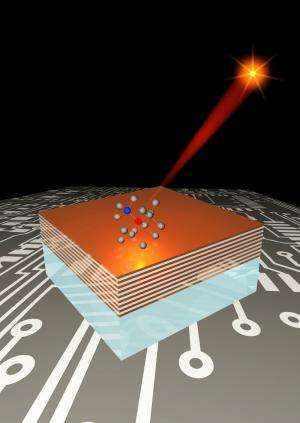'Single-photon emission enhancement' seen as step toward quantum technologies

(Phys.org)—Researchers have demonstrated a new way to enhance the emission of single photons by using "hyperbolic metamaterials," a step toward creating devices in work aimed at developing quantum computers and communications technologies.
Optical metamaterials harness clouds of electrons called surface plasmons to manipulate and control light. Purdue University researchers had previously created "superlattices" from layers of the metal titanium nitride and the dielectric, or insulator, aluminum scandium nitride. Unlike some of the plasmonic components under development, which rely on the use of noble metals such as gold and silver, the new metamaterial is compatible with the complementary metal–oxide–semiconductor manufacturing process used to construct integrated circuits.
The metamaterial is said to be hyperbolic, meaning it possesses unique properties leading to the increased output of light. In new findings the researchers have demonstrated how attaching nanodiamonds containing "nitrogen-vacancy centers" to the new metamaterial further enhances the production of single photons, workhorses of quantum information processing, which could bring superior computers, cryptography and communications technologies.
"These results indicate that the brightness of the nanodiamond-based single-photon emitter could be substantially enhanced by placing such an emitter on the surface of the hyperbolic metamaterial," said Alexander Kildishev, associate professor of electrical and computer engineering at Purdue. "The single-photon emitters could be used to build highly efficient room temperature CMOS-compatible single-photon sources."
Research findings are detailed in a cover paper appearing in the Jan. 15 issue of Laser & Photonics Reviews. The work was a collaboration of researchers from Purdue, the Russian Quantum Center, Moscow Institute of Physics and Technology, Lebedev Physical Institute, and Photonic Nano-Meta Technologies Inc.
A nitrogen-vacancy center is an atomic-scale defect formed in the diamond lattice by substituting a nitrogen atom for a carbon atom and creating a neighboring void in the lattice. Placing a nanodiamond containing an NV center on the surface of hyperbolic metamaterials not only enhances the emission of photons, but also changes the pattern of light emitted, a trait that could be important for the development of quantum devices, said graduate student Mikhail Y. Shalaginov, the paper's lead author. He and Kildishev are working with a team of researchers led by Vladimir M. Shalaev, scientific director of nanophotonics at Purdue's Birck Nanotechnology Center and a distinguished professor of electrical and computer engineering, and Alexandra Boltasseva, an associate professor of electrical and computer engineering. Professors Shalaev, Kildishev and Boltasseva are a part of a Purdue "preeminent team" working on quantum photonics.
Because the studied system represents a stable source of single photons that functions at room temperature, it is potentially practical for commercial applications. When exposed to a laser light, the system rises from its "ground state" to an excited state, which causes it to spontaneously emit a photon.
Discover the latest in science, tech, and space with over 100,000 subscribers who rely on Phys.org for daily insights. Sign up for our free newsletter and get updates on breakthroughs, innovations, and research that matter—daily or weekly.
"We are interested in causing it to emit faster so that we can increase the rate of these photons coming out," Kildishev said.
Findings show the system is capable of producing single photons faster, in larger quantities, and more directionally.
Metamaterials have engineered surfaces that contain features, patterns or elements, such as tiny antennas or alternating layers of nitrides that enable unprecedented control of light. Constructed of artificial atoms and molecules, the optical metamaterials owe their unusual potential to precision engineering on the scale of nanometers.
Quantum computers would take advantage of phenomena described by quantum theory called "superposition" and "entanglement." Instead of only the states of one and zero that exist in conventional computers, there are many possible "superposition quantum states." Computers based on quantum physics would have quantum bits, or "qubits," increasing the computer's capacity to process, store, and transmit information. The nitrogen vacancy also makes it possible to potentially record information based on the nuclear or electron "spin" state of the center, which is promising for quantum computing. The spin can be either "up" or "down" - forming the quantum superposition of the up and down states - representing a new technology for processing information.
Future research may include work to improve the system with devices that combine the hyperbolic metamaterial with nanoantennas and optical waveguides to increase its efficiency and make it more compact. The ongoing work also may strive to improve the "spin properties" of the system with nitrogen-vacancies and to study the optical contrast between the up and down states.
More information: Enhancement of single–photon emission from nitrogen–vacancy centers with TiN/(Al,Sc)N hyperbolic metamaterial, Laser & Photonics Reviews, 2015.
Provided by Purdue University


















